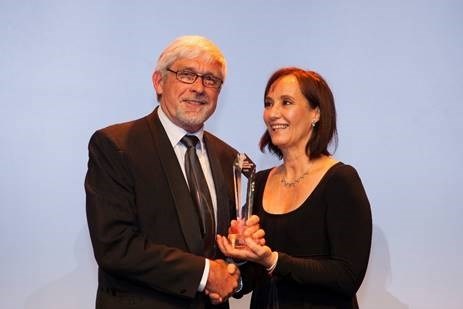Langkloof Bricks in Jeffreys Bay currently burns waste tyres at 1200°C, to dry the clay bricks. Thereafter, the bricks are fired with coal in the Vertical Shaft Brick Kilns (VSBKs). Langkloof Bricks currently receive about 25,000 tyres from the Recycling and Economic Initiative of South Africa (REDISA) per month. REDISA supplies the tyres at no cost to Langkloof Bricks, who is paid a subsidy for every tonne processed.

Nico Blake (right), executive director of Langkloof Bricks who won the Environmental Impact Award. Standing next to him is REDISA director, Charlie Kirk.
The company currently uses the VSBK technology, which uses hot exhaust gasses for the gradual preheating of the unfired bricks in a continuous process. This reduces energy consumption and CO2 emissions by up to 50%, compared to the more commonly-used clamp kilns. According to the International Energy Agency’s 2015 report, the construction industry is responsible for 23% of the country’s greenhouse gas emissions (GHGs), with clay bricks predominantly still being fired in energy-inefficient and highly-polluting clamp kilns.
Langkloof Bricks is committed to reducing their environmental impact. Last year they were awarded at REDISA’s Inaugural Recognition Awards for their work and dedication to minimising their environmental impact through environmental impact assessments and infrastructure development. The company currently employs 130 permanent staff and has the capacity to process over 40 million bricks annually.
Reducing carbon emissions
“At REDISA, when we talk about sustainability, we don’t only focus on reducing carbon emissions - we also think about our impact on other natural resources and how we can increase the life cycle of some of these resources. This is what drives our business and what we would like everyone to implement in their own businesses”, says Stacey Davison, director at REDISA.
“Given that the world will be home to 5-billion middle class consumers within the next 20 years, natural resources are being placed under increasing stress to meet housing, product and lifestyle demands. To reduce this pressure, REDISA has realised that waste should be looked at differently - not as waste but as something with value,” says Davidson.
According to Nico Blake, executive director at Langkloof Bricks, “We believe the VSBK technology has fundamentally improved the way many clay brick manufacturers think about production, from an economic, social and environmental perspective. We also see this as an opportunity to continue to minimise our impact on the environment, by reducing and transforming waste into a resource, in addition to contributing towards energy efficiency, air quality and climate change through the successful implementation of our technology.”






























